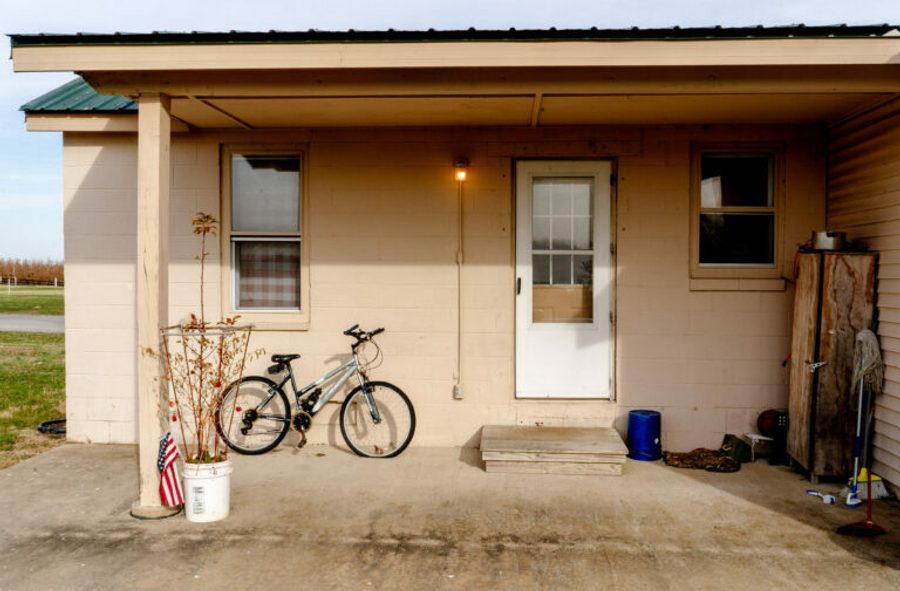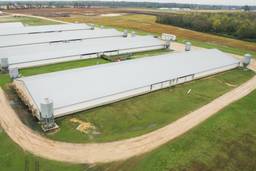Oversight Has Led to Better Housing for Migrant Farmworkers. Why Aren't Some States Doing It?
With no national regulation, employers often provide subpar housing to the migrant farmworkers who sustain the billion-dollar food industry.
Johnathan Hettinger and Sky Chadde

Editor’s Note: This article was originally published by Investigate Midwest and was supported by the Pulitzer Center for Crisis Reporting.
Belinda Cantu seemed perplexed.
State inspectors were questioning her about the building where she planned to house migrant farmworkers in rural western Iowa. The inspectors already had visited twice before, and Cantu had failed to remedy some identified problems — a missing shower head, a rat infestation, a toilet that didn’t flush. But one issue seemed to stump her.
“You’re required to provide them with toilet paper,” an inspector said.
“We have to??” Cantu responded, according to a 2017 transcript Investigate Midwest obtained via a public records request. (The transcript includes two question marks.)
Across the country, farmworkers, who perform the menial jobs that sustain the billion-dollar agriculture and food companies, often endure subpar, unhealthy housing. In this case, though, the inspection had done its job: When inspectors visited again the following year, Cantu had corrected all the problems, according to state inspection records. She did not respond to multiple requests for comment for this story.
But the inspection is an anomaly in Iowa.
The Iowa Department of Health and Human Services oversees housing for domestic farmworkers (another agency oversees housing for farmworkers on guest visas). Despite approving applications for multiple labor camps each year, including 18 this past year, the agency only inspects housing when it receives a complaint, a state spokeswoman said. It hasn’t conducted an inspection since 2018, the spokeswoman confirmed.
A flaw of relying on complaints is that farmworkers often don’t report housing problems to their employers because they fear retaliation and, in some cases, deportation, advocates and experts said.
“It’s a unique situation where often your boss and your landlord are one and the same,” said Lorraine Gaynor, an attorney at Iowa Legal Aid, of many farmworkers’ living arrangements. “If you make a complaint about the housing, you may fear that that’s going to have an adverse effect on your job,” such as being given worse job duties or being fired.
The agency spokeswoman did not respond to a question about possible flaws in complaint-driven inspections.
In some cases, farmworkers have been forced to live with shattered windows, leaky doorways and broken fridges. Some are crammed into trailers. Bed bugs are a common concern. One person told Centro de Los Derechos del Migrante, an advocacy group based in Mexico, they lived in an “iron chicken coop” with bunk beds.
An entire regulatory apparatus, enforced by the federal government, exists to inspect housing for farmworkers on guest, or H2A, visas. No such system exists for migrant or domestic farmworkers, resulting in patchwork and often weak oversight among Midwestern states, according to an Investigate Midwest review of state regulations.
Not all migrant or domestic farmworkers live in employer-provided housing — the kind that needs to be inspected — while working, but many, especially in the Midwest, do, according to federal surveys.
The differences among states range from no system to inspect domestic farmworker housing (Missouri) to multiple inspections of the same housing in the same year (Michigan and Illinois).
“Not all housing is horrible, but there are many situations in which there certainly are workers living in substandard housing,” said Amy Liebman, chief program officer at the Migrant Clinicians Network, a national nonprofit headquartered in Austin, Texas. “And there are some good reasons to have some sort of local oversight, but, by and large, I think that leads to discrepancies and differences.”
Despite news stories — including in-depth stories in 2016 and 2019 from Investigate Midwest — and studies over the past 60 years on poor housing conditions, there has been no successful, concerted effort nationwide to change them.
“For decades and decades, housing for many migrant and seasonal farmworkers has not changed over time,” said Claudia Corwin, a staff physician at University of Iowa Occupational Health who also works with Proteus, a federally qualified health center that provides primary care to migrant and seasonal farmworkers. “Housing is one of the fundamental social determinants of health.”
In the short-term, she said, if housing doesn’t provide access to clean water, it’s difficult to remain hydrated — an important goal for people laboring under the sun for hours. But unsafe or unhealthy housing might also affect a person’s long-term health. For instance, Corwin said, Proteus often sees farmworker patients with high blood pressure or poorly controlled diabetes. This could be a result of not being able to keep fresher, healthier food due to poor refrigeration, an issue state inspectors have noted across the Midwest, according to the inspections Investigate Midwest has obtained.
Many farmworkers live and legally work in the U.S. Some reside near the fields they work in, and some travel from Texas or Florida for seasonal harvests or jobs in the Midwest. Others visit the U.S. on guest visas for a specific period of time, usually a few months, before returning to their home country. A vast majority of these H2A visa workers come from Mexico.
Both domestic workers and visa-holders, who nominally have more protections, have experienced unsanitary and unhealthy living conditions.
Data on the number of dilapidated houses that farmworkers live in is difficult to come by. States hold the records, many of which are just on paper. In the past five years, the Occupational Safety and Health Administration has only fined about 50 employers — a fraction of the number of total agricultural employers — for violations related to temporary labor camps, according to government data.
The workers are a crucial component in the food supply chain, performing labor that machines can’t. They pick and package fruits and vegetables to ensure modern grocery store convenience. They also work, through labor contractors, for multi-billion dollar agribusinesses.
For instance, in Illinois, migrant workers detassel corn, a critical step in helping companies such as Corteva and Bayer develop corn seeds that can produce higher yields for farmers. Big Ag companies often continue to use labor contractors that have been accused of abuse, Investigate Midwest found in 2017.
In Illinois, two agencies share responsibility for inspecting farmworker housing, the Department of Public Health and the Department of Employment Security. The health agency, which inspects migrant and H2A worker housing, has several offices across the state where inspectors are based.
The state inspects the housing before workers arrive. Then, to ensure any problems it identified have remained fixed, it inspects the housing again while workers are present.
Recently, Illinois inspectors have found housing with mold, rodent infestations, and showers with no hot water, inspection records obtained through a public records request show. Many didn’t have the required emergency contacts posted or batteries in smoke detectors. (A few owners of the inspected housing that Investigate Midwest spoke to said workers would remove the batteries, so they could cook.)
The consistent oversight in Illinois has made some employers rethink their approach to housing.
Larry Trover, a farmer in southern Illinois who employed farmworkers to help harvest tomatoes, decided to stop growing the crop and focus entirely on soybeans, which requires less money spent on labor. State inspectors found no violations at his housing over the past five years.
“These small farmers just can’t afford it,” he said. “It’s get big or get out. We chose to get out.”
Another employer, a temporary staffing agency that connects farmers with labor contractors named Advance Services Inc., prefers using migrant workers because the housing standards are easier to navigate than for H2A workers, said Christy Sandall, the company’s administrative director.
Advance Services operates in six to eight states annually, and inspectors in Illinois have dinged the company for not posting required signage. The company has settled on housing workers in hotels because of inconsistent regulation, she said.
“It’s all over the place,” Sandall said of state standards. “It just depends on each state.”
One job, two populations
Government interviews with domestic and migrant farmworkers stretching back to the early 1990s paint a picture of a largely settled, older population. In 1993, about two-thirds reported owning their own home or renting from someone other than their employer. In 2020, the figure was four out of five. Most live within an hour’s drive of worksites.
Regional differences exist, according to the survey data. A small number of respondents lived in the Midwest during the most recent survey, but about 60% said they either rent or own their home. The figure was about 80% in the rest of the country.
Still, while the Midwest might see more migration than other regions, the number of domestic farmworkers traveling for work has declined over the years, said James Johnson, the director of the Environmental Stewardship Division, the state agency in the Michigan Department of Agriculture & Rural Development that inspects farmworker housing.
“Traditional migrants moved up from Texas, Georgia, Florida into Michigan, and we’re seeing less and less of those more traditional migrant movements than we have in the past,” said Johnson, who’s been regulating the state’s industry since 1987.
Another trend over the past 30 years is the increasing age of domestic farmworkers. In 1993, the average age of a farmworker was about 31 years old. In 2020, it was about 42. Most have lived in the U.S. for more than a decade at least.
While domestic farmworkers aged and settled down, employers turned to a different source of labor — the H2A visa. Since 2006, the number of workers who have worked in the U.S. through the program has increased more than 350%.
Midwestern states with only a few hundred H2A workers a decade ago now have several thousand H2A workers. Michigan farmers, for instance, employed about 350 visa workers in 2012. Just eight years later, it was almost 10,000.
The federal government mandates inspections of H2A housing. It requires certain standards to be met, such as enough room for each person. But even then, oversight can be lax.
For instance, in 2018, a labor contractor named Jorge Marin applied to house H2A workers in Kennett, Missouri. He told regulators he’d keep them in two houses, but he didn’t say anything about an old county jail he’d recently purchased. The jail had recently served as the community’s Halloween haunted house.
When a state inspector arrived in town, Marin told her no one would stay in the jail, Investigate Midwest reported. She left without inspecting it. But when workers arrived, Marin moved them into the old jail. The bathrooms had no lights and the showers were cold, investigators later found.
Advocates have pointed to a lack of funding as one reason problems persist with H2A housing. Until recently, states had to process an increasing number of applications for workers while receiving the same amount of grant funding.
Between 2006 and 2016, the number of workers in the H2A program increased 180%. The grant money to states during that time just rose with inflation, from about $12 million to $14 million.
However, the federal government now provides an extra $7 million that is split among states to implement their programs, according to federal paperwork. This raises the total number to about $21 million.
No eyes on some housing in Iowa, Missouri
Iowa first learned about problems at Cantu’s building, located in the 2,800-person town of Onawa, in 2016, according to inspection records. Inspectors discovered little to no hot water available, mouse droppings in a bedroom and mattresses on the floor.
The state asked the owners, Belinda and Paul Cantu, to send in photos of the necessary repairs, and it informed them the state would inspect the building again next year before workers arrived.
In 2017, inspectors confronted Belinda about the building’s issues, according to the transcript. But the problems were resolved by 2018, records show.
Gaynor, the legal aid attorney, said most of the concerns about housing she’s heard come from migrant farmworkers, not H2A workers. She attributes this to the state not having an in-person, pre-occupancy inspection for migrant worker housing.
“When there’s not an actual human being going out to lay eyes on the place before workers come, it’s just not the same level of assurance that everything is as it should be,” she said. “You’re relying on camp operators to make that assessment themselves.
“They may have some self-interest in maybe bending the truth somewhat so they don’t have to pay to make some repairs,” she continued. “Or maybe there’s not even any malice. Maybe they just don’t understand the regulations as well as an inspector would and so they think they’re complying, but they’re not.”
She also suspects, she said, not all farmworker housing outside of the H2A program is recorded with the state. The number of employers that apply for state permits is low, she said — just about 20.
A reliable number of farmworkers in the state is difficult to come by, but the state estimates about 23,000 farmworkers lived in Iowa in 2021, Gaynor said. About 40% are domestic farmworkers.
“Anyone that is aware of a migrant camp as defined in Iowa Code 138 that is operating without a permit is encouraged to notify the Division of Public Health at the Iowa Department of Health and Human Services,” the Iowa health agency’s spokeswoman said.
In Iowa, there is at least the potential for inspectors to visit potentially problematic housing. But, in Missouri, there’s not even that: No state agency is responsible for permitting domestic farmworker housing.
One Missouri town is a good example of the kinds of housing available to migrant farmworkers, said Axel Fuentes, an advocate who works with agricultural laborers, including meatpacking workers.
Milan sits near the Missouri-Iowa border. Without many options available in the 2,000-person town, many rent out trailers, Fuentes said.
“You see them in deplorable conditions, including some without windows,” he said in Spanish, “but even so they keep renting to people.”
He said he knows of eight or nine people living in a one-room apartment.
In Missouri, the state’s Department of Higher Education & Workforce Development inspects H2A housing. But it has “no legal authority to inspect the housing of domestic farmworkers,” an agency spokeswoman said.
Farmworkers in hotels, student housing in Illinois
In recent years, some employers in Illinois have used housing that non-farmworkers stay in, including hotels and student housing.
Ryan Prevo, of Young America Realty in Normal, said he rents apartments to college students during the school year and to migrant workers in the summer.
“We’ve been glad for the workers,” he said. “They fill up some vacancy for us.”
In at least one case, state oversight pushed one employer to move workers into motels.
J & S Agriculture employs workers to detassel corn and weed soybean fields. State inspectors have cited it for too many cots in bedrooms, malfunctioning stoves and fridges, and not enough tables and chairs, according to state records.
But now it uses hotels, said Sonia Munoz, its operator. They’re much easier to maintain than her own housing, she said.
“It’s much easier. I’ve never had any issues,” Munoz said. “It’s more efficient for me and for the workers. The bus driver takes them to get groceries, wash clothes. We leave our vans, so they can move around.”
Each year, seven inspectors from the Department of Public Health inspect the 22 migrant labor camps, once before occupancy and once in the middle of the season. Mike Claffey, a spokesman for the Illinois Department of Public Health, said in an emailed statement that inspections occurring prior to opening day allows for operators to fix violations before workers are living in the housing.
“The operators of migrant labor camps know they will not be issued a license to operate if they have violations. Because of this, operators address violations on the spot to ensure the license is issued prior to the date the camp is scheduled to open,” said Claffey.
Because of inspectors being “very aggressive in addressing/fixing any violations,” IDPH has not issued any fines for housing in recent years, Claffey said.
Rebecca Cisco, a spokeswoman for the Illinois Department of Employment Security, said that the agency wants workers to submit complaints to the department or federal oversight agencies, such as OSHA and the Department of Labor, if they have poor housing.
“It must be stressed that any housing issues after the inspection is completed must be reported to the Department,” Cisco said in an emailed statement. “IDES encourages workers who may be impacted by poor housing conditions to submit complaints, so they can be properly addressed and fixed.”
Critical vs. incidental violations in Michigan
In Michigan, migrant workers and H2A workers are afforded the same housing oversight. Like Illinois, Michigan inspects its farmworker housing twice — once before occupancy and during.
A separate agency processes the paperwork employers file for H2A workers. That allows seven staffers of Johnson’s agency to inspect housing full-time.
While on the premises, state inspectors are looking for two kinds of violations, said Johnson, the division director in Michigan. There are incidental violations, such as ripped screens, and critical, such as exposed wiring, he said. If there are critical violations, the state won’t license the housing.
“You cannot occupy that housing until that critical violation is actually addressed,” he said.
For instance, late last year, an inspector found one house had a deck that was likely to collapse and exposed wiring in the water heater closet. The inspector did not recommend the house get a license, according to state records.
While the state agency can’t fine employers for bad housing, it can issue fines if it finds employers operating housing without a permit.
Each year, Johnson said, about 90,000 domestic workers and their families come to Michigan. About 27,000 of those live in housing that the state inspects, he said. Michigan has 38 different crops that require picking by hand, and, due to the variety of those crops’ seasons, workers come to the state year round, he said.
“Good housing attracts migrants,” Johnson said. “If you have lousy housing, I can’t imagine why people would want to come to your state in order to work.”
Galen Zavala Sherby contributed to this story.
Investigate Midwest is an independent, nonprofit newsroom. Our
mission is to serve the public interest by exposing dangerous and costly
practices of influential agricultural corporations and institutions
through in-depth and data-driven investigative journalism.Visit us
online at www.investigatemidwest.org.
Investigate Midwest is continuing to report on farmworker housing across the Midwest and the country. As part of the project, we’re requesting inspection records in each state.
To send us a tip or ideas about farmworker housing you think should be covered, contact our reporters at sky.chadde@investigatemidwest.org or jhettinger@investigatemidwest.org, or find ways to contact us securely here.
Johnathan Hettinger is a journalist based in Central Illinois, where he grew up. A graduate of the University of Illinois, he has worked at the Midwest Center for Investigative Reporting, the Livingston Enterprise and the (Champaign-Urbana) News-Gazette. Contact Johnathan at jhett93@gmail.com and follow him on Twitter @jhett93.
Sky Chadde is the managing editor for Investigate Midwest. Previously, Chadde was the Center’s USA TODAY Agriculture Data Fellow. In 2019, he graduated from the Missouri School of Journalism with a master’s degree in investigative reporting. He’s covered Missouri state government for the Columbia Missourian and the St. Louis Post-Dispatch. Before grad school, he was a reporter in Texas, covering local governments and law enforcement. At Investigate Midwest, he focuses on data journalism.










